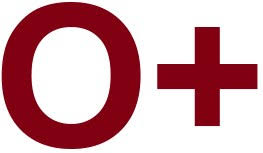1. Most Common Blood Type
The O positive blood type is the most common and incredibly an important donor in maintaining adequate blood supply. It is present in 1 out of 3 individuals. This means approximately 37.4% of the population has O positive blood. However, not all of the ethnic groups share the same proportions of blood types. O positive blood type is about 37% in Caucasians, 47% in African American, 53% in Hispanic, and 39% in Asian.
2. Inheritance Patterns
The ABO gene found on chromosome 9 determines the ABO blood group system. O genes (or alleles) do not produce antigens A or B, thereby are called silent alleles. Blood Group O has neither A or B antigen on red cells but with both the A and B antibody in the plasma.
How is O Positive blood type inherited?
If parental blood groups consist of O and O, the child’s blood group will be O.
If parental blood groups consist of O and A, the child’s blood group will either be O or A.
If parental blood groups consist of O and B, the child’s blood group will either be O or B.
If parental blood groups consist of A and A, the child’s blood group will either be O or A.
If parental blood groups consist of A and B, the child’s blood group will either be one of O, A, B, or AB.
If parental blood groups consist of B and B, the child’s blood group will either be O or B.
Read interesting facts about blood donation here.
3. Blood Type Compatibility: O+ Can Receive Both O+ and O-
Being the most common blood type, it is transfused most often. O Positive individuals can only receive both O+ and O- because they have antibodies to both A and B antigens in their blood. If A and B is introduced, it will cause an immune response.
4. Blood Type Compatibility: O+ Can Be Given To O+, A+, B+ and AB+
Being an O+ donor makes the person the type of individual to hold being the most ideal red blood benefactor. Individuals with an O+ blood type can be a red blood cell donor to blood types O+, A+, B+, and AB+.
5. Plasma Type Compatibility: O Can Receive O, A, B and AB
Blood Type O carries both antibodies, making blood type O group compatible to receive plasma from groups O, A, B and AB. However, blood type O plasma can only be given to type O recipients. The individuals who are compatible in receiving platelets from an O+ donor are O+ recipients.
6. Has an Rh Factor
Rh Factor is an additional marker in the blood. This can be classified as either Rh positive or Rh negative. This marker is only used for genetic differences. O Positive blood type is Rh positive. Also read about O Negative Blood Type.
7. Tendency Towards Higher Levels of Stomach Acids
Individuals with blood type O may be predisposed to certain medical conditions like ulcers. This can happen because of higher levels of stomach acids. However, they have well-built ability to digest protein and fat-rich meals. The two chemicals intestinal alkaline phosphatase enzyme and ApoB48 lipoprotein used by the digestive tract are secreted at much higher levels. It improves the ability of blood type O individuals to metabolize animal sourced cholesterol more efficiently. However, simple carbohydrates such as those sourced from grains, are easily converted into triglycerides and fats.
8. Immediate “Fight or Flight” Response
This can cause episodes of excessive anger, hyperactivity, temper tantrums, and chemical imbalance bringing about manic experiences. Blood Type O individuals are also vulnerable to destructive behaviors when exceedingly bored, tired or depressed, due to the synergistic relationship between feelings of reward and release of dopamine.
9. Diet Recommendations
It is recommended for blood type O individuals to focus their diet on organic meats, fruits and vegetables to avoid being overstressed. Moreover, dairy and wheat products should be avoided because they may initiate digestive and health concerns. Intake of caffeine and alcohol should also be avoided. They can be harmful with their potential to increase adrenaline and noradrenaline which are already in high levels in blood type O individuals.
10. Exercise Recommendations
Brisk regular exercise that promotes the musculoskeletal and cardiovascular system can be beneficial. Physical exercise releases a crowd of neurotransmitter activity to tone the whole system. It also helps uphold a physical health and emotional balance due to a well regulated and efficient chemical transport system. Aaerobic physical exercise should be done 3 to 4 times a week for at least 30 minutes each.



 Contact Us
Contact Us







 Hospitals
Hospitals
 Doctors
Doctors
 Diagnostic
Diagnostic
 Pharmacy
Pharmacy
 Health Tips
Health Tips
 Blog
Blog

























Comments